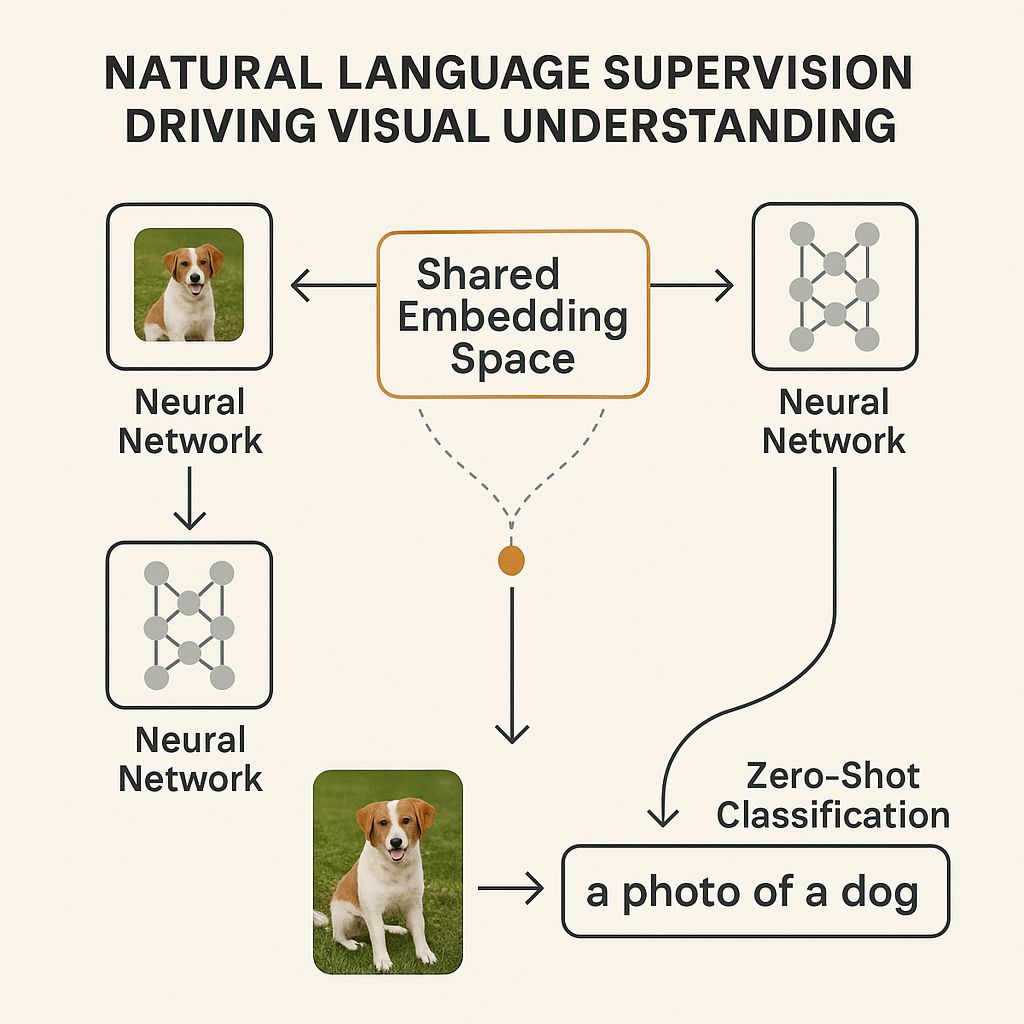In recent years, the landscape of computer vision has shifted dramatically. While traditional models have long relied on manually labeled datasets and rigid category structures, a groundbreaking approach has emerged—learning transferable visual models from natural language supervision. This method, best exemplified by OpenAI’s CLIP (Contrastive Language–Image Pre-training), unlocks a new era in visual understanding by training models using freely available image-text pairs from the internet.
Let’s explore how this works, why it matters, and what it means for the future of machine learning.
The Traditional Challenge in Computer Vision
For decades, computer vision models required massive datasets like ImageNet, where each image was carefully annotated with predefined labels. While effective, these models had limitations:
- They struggled to generalize beyond their training classes.
- They needed expensive, time-consuming human labeling.
- They were hard to scale across domains where labeled data was scarce.
This bottleneck called for a more scalable, flexible way to train models—one that could harness the rich, descriptive information humans naturally use: language.
Enter CLIP: Contrastive Language–Image Pre-training
Developed by OpenAI, CLIP is a framework that learns visual concepts from natural language without the need for explicit supervision. Instead of relying on fixed labels, CLIP is trained on 400 million image-text pairs sourced from the internet.
At its core, CLIP is built on a contrastive learning objective. This means it learns to match images with their correct textual descriptions while pushing apart mismatched pairs in a shared embedding space.
For example, given a photo of a dog and several sentences like:
- “A photo of a cat”
- “A photo of a car”
- “A photo of a dog”
CLIP learns to align the image most closely with the correct phrase, “a photo of a dog,” while distinguishing it from the incorrect ones.
How CLIP Works: Images Meet Language
CLIP uses two neural networks:
- One processes images (like a traditional vision transformer or CNN).
- The other processes text (using a transformer-based architecture similar to GPT or BERT).
These networks are trained together to produce similar embeddings (i.e., vector representations) for image-text pairs that match, and dissimilar embeddings for those that don’t.
The result? A shared semantic space where both images and text live side-by-side. This allows CLIP to understand and compare content across modalities.
Zero-Shot Learning: Why CLIP is So Powerful
One of CLIP’s most exciting features is its ability to perform zero-shot learning. After pretraining, CLIP can be applied to entirely new tasks without further fine-tuning.
Imagine asking the model to classify an image between categories like:
- “A photo of a pizza”
- “A photo of a salad”
- “A photo of a burger”
CLIP simply compares the image to each description and picks the most similar one. It doesn’t need to see labeled examples of pizzas, salads, or burgers during training—just the text and image data used during its contrastive pretraining.
This flexibility allows CLIP to outperform many specialized models in tasks where labeled data is limited or unavailable.
Broader Applications and Versatility
CLIP’s ability to align text and image data opens up a world of applications:
- Image Classification: Works out of the box across thousands of categories.
- Content Filtering: Helps detect offensive or unsafe content by matching with descriptive prompts.
- Image Search and Retrieval: Enables natural language queries like “sunset over a mountain” to find matching images.
- Object Detection and Captioning: Assists more complex systems in identifying and describing visual scenes.
- Image Generation: Works with models like DALL·E to guide image generation based on language prompts.
Implications for the Future of AI
CLIP’s success signals a paradigm shift:
- Learning from the Web: Models can now be trained on noisy, natural data instead of curated labels.
- Multimodal Intelligence: Text and vision are no longer separate—models can now understand both in harmony.
- Scalability and Flexibility: With minimal task-specific adjustments, CLIP-like models can adapt across domains, from art to medicine to industrial automation.
Conclusion
Learning transferable visual models from natural language supervision marks a transformative leap in artificial intelligence. By training models like CLIP to understand images and language together, we move closer to AI systems that can perceive and reason more like humans—across contexts, tasks, and data types.
This approach is not only more efficient but also more inclusive of the richness of human communication. As research continues, expect to see more applications where language and vision work hand-in-hand to build smarter, more adaptable, and more intuitive AI.
What does “learning transferable visual models from natural language supervision” mean?
It refers to training visual models using image-text pairs instead of manually labeled datasets, allowing the model to understand and generalize visual concepts through natural language.
What is CLIP and how does it work?
CLIP (Contrastive Language–Image Pre-training) is a model developed by OpenAI that learns to associate images and text by training on 400 million image-caption pairs using a contrastive learning approach.
What is contrastive learning in CLIP?
Contrastive learning teaches the model to match each image with its correct description and distinguish it from incorrect ones by learning in a shared embedding space for both images and text.
How does CLIP enable zero-shot learning?
CLIP can classify new images by comparing them to a set of textual prompts—without needing task-specific fine-tuning—making it highly flexible and generalizable across domains.
What are the practical applications of CLIP?
CLIP is used for image classification, content filtering, image retrieval, guiding image generation, and enabling human-like understanding of visual content in AI systems.


